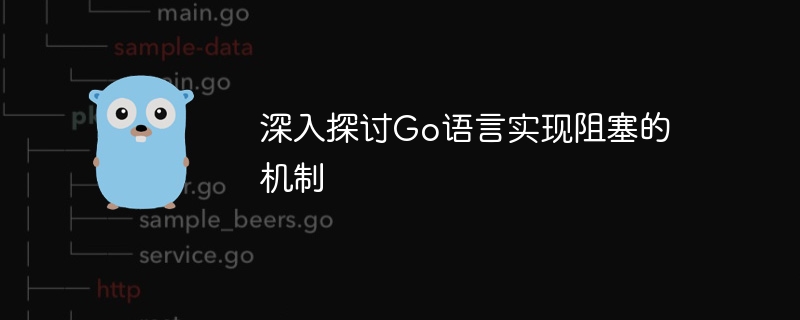Home >Backend Development >Golang >In-depth discussion of the mechanism of blocking in Go language
In-depth discussion of the mechanism of blocking in Go language
- WBOYWBOYWBOYWBOYWBOYWBOYWBOYWBOYWBOYWBOYWBOYWBOYWBOriginal
- 2024-03-25 08:24:03486browse

Go language is a lightweight concurrent programming language. Its powerful concurrency features make it perform well in handling large-scale concurrent tasks. In the Go language, blocking is a common programming pattern that can be implemented through channels and goroutines. This article will deeply explore the mechanism of blocking in Go language, including the principle of blocking and specific code examples.
In the Go language, blocking refers to an operation that temporarily stops execution when a program encounters certain conditions that cannot be met during execution, and then continues execution after waiting for the conditions to be met. Blocking is often used to handle synchronization operations in concurrent tasks to ensure that tasks are executed in a specific order.
In the Go language, the blocking mechanism can be implemented through channels. Channels are widely used in Go language for communication and synchronization between goroutines. A channel is a data structure that can transfer data between different goroutines and can implement blocking and non-blocking operations.
package main
import (
"fmt"
"time"
)
func main() {
ch := make(chan int) // 创建一个int类型的通道
go func() {
time.Sleep(time.Second)
ch <- 1 // 将数据1发送到通道ch
}()
fmt.Println("Waiting for data...")
data := <-ch // 从通道ch接收数据,如果通道中没有数据,则阻塞等待
fmt.Println("Data received:", data)
}In the above code example, a channel of type int is first createdch, then an anonymous goroutine is started, and data 1 is sent to the channel after waiting for 1 second in the goroutinech. In the main function, data is received from the channel ch through . If there is no data in the channel, it will block and wait until the data is sent to the channel. The execution will not continue. .
In addition to blocking and waiting for data to be sent to the channel, you can also implement non-blocking operations on multiple channels through the select statement. The select statement can monitor multiple channels at the same time. Once data arrives in one of the channels, the corresponding operation will be performed.
package main
import (
"fmt"
"time"
)
func main() {
ch1 := make(chan int)
ch2 := make(chan string)
go func() {
time.Sleep(2 * time.Second)
ch1 <- 100
}()
go func() {
time.Sleep(3 * time.Second)
ch2 <- "Hello"
}()
select {
case data := <-ch1:
fmt.Println("Data received from ch1:", data)
case data := <-ch2:
fmt.Println("Data received from ch2:", data)
case <-time.After(4 * time.Second):
fmt.Println("Timeout")
}
}In the above code example, two channels ch1 and ch2 are created at the same time, and two goroutines are started to send messages after 2 seconds and 3 seconds respectively. The corresponding channel sends data. Monitor two channels through the select statement. Once data arrives in one of the channels, the corresponding operation can be performed. In addition, a timeout can be set through the time.After function. If no data arrives from any channel within the specified time, a timeout operation will be performed.
In summary, through the combination of channels and goroutines, the Go language implements a powerful blocking mechanism, which can easily handle synchronization operations in concurrent tasks. The principle of blocking is simple and intuitive. The implementation of blocking and non-blocking operations is demonstrated through sample code. I hope it will be helpful to readers.
The above is the detailed content of In-depth discussion of the mechanism of blocking in Go language. For more information, please follow other related articles on the PHP Chinese website!

